[Editor’s Note: EDRM is proud to publish Ralph Losey’s advocacy and analysis. The opinions and positions are Ralph Losey’s copyrighted work.]
Political polarization in the United States has reached unprecedented levels, threatening the nation’s social fabric and democratic processes. To tackle this growing crisis, this article proposes a streamlined, three-phase, eleven-step framework developed collaboratively with today’s leading AIs, ChatGPT and Google Gemini. This plan, grounded in practicality and inclusivity, focuses on empowering individuals, communities, and institutions to rebuild trust and unity. By addressing issues like civic education, media literacy, local leadership, and electoral integrity, the framework seeks to heal our ‘House-Divided’ through incremental, measurable steps.
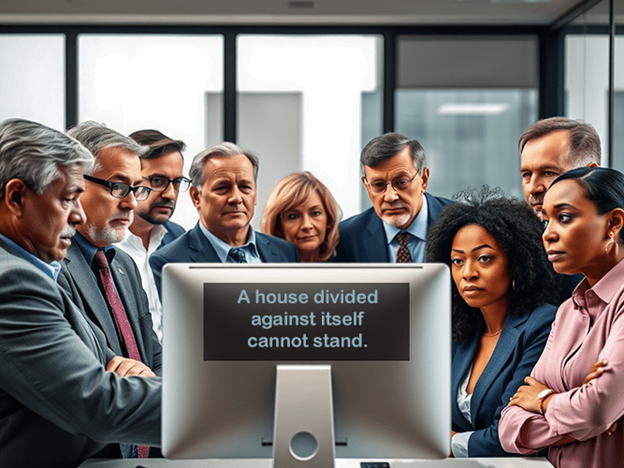
Introduction to the Plan to Start to Heal a Divided Country
The plan to repair the ‘house-divided’ has three stages.
- First Phase: Laying the Groundwork for Unity — This phase focuses on creating the foundational conditions necessary for rebuilding trust and collaboration among Americans. By promoting civic education, fostering empathy through dialogue, and empowering local leaders, Phase 1 sets the stage for more transformative change in later phases.
- Second Phase: Collaborative Action for Polarization Reduction — This phase focuses on actionable steps to combat the root causes of division in media, technology, and communities. By empowering citizens with media literacy skills, reforming technology use, and fostering collaborative projects, Phase 2 works to reduce polarization in tangible, visible ways.
- Third Phase: Sustaining Unity Through Systemic Change — This final phase ensures the sustainability of unity efforts through systemic reforms that foster fairness, reduce inequality, and create a culture of empathy and collaboration. By addressing both institutional and cultural dimensions, this phase solidifies long-term reconciliation.
By systematically addressing polarization through these structured phases, the plan provides a practical roadmap for rebuilding unity in America. The early phases focus on achievable, visible goals—like empowering local communities and fostering collaboration—while later phases lay the groundwork for systemic, long-term reforms. This phased approach ensures that resources are used effectively, progress is measurable, and the plan can adapt to evolving challenges and feedback.

First Phase: Laying the Groundwork for Unity
- Step 1: Encourage Local Leadership and Autonomy
- Step 2: Promote Civic Education and Shared American Identity
- Step 3: Foster Empathy Through Cross-Group Dialogue and Perspective-Taking
Second Phase: Collaborative Action for Polarization Reduction
- Step 4: Promote Media Literacy and Trusted Information Ecosystems
- Step 5: Promote Ethical Technology Use and Respectful Online Engagement
- Step 6: Incentivize Community Collaboration on Shared Issues
- Step 7: Create Platforms for Bipartisan Citizen Engagement
Third Phase: Sustaining Unity Through Systemic Change
- Step 8: Build Trust in Electoral Integrity
- Step 9: Support Bipartisan Political Reforms
- Step 10: Address Socioeconomic Disparities
- Step 11: Embed Empathy and Perspective-Taking into Institutions
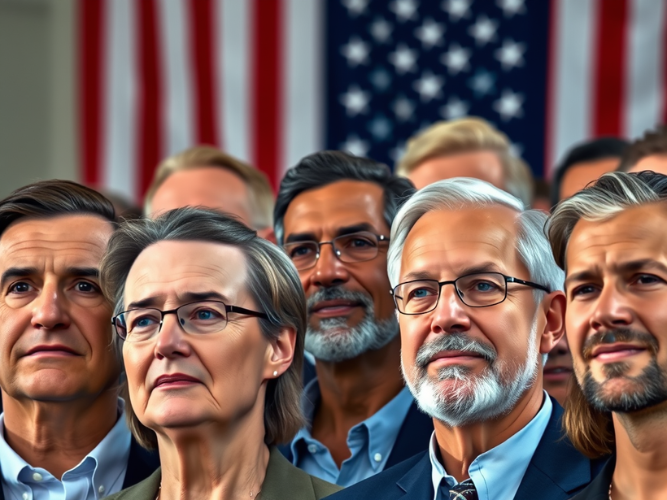
Ralph Losey’s Personal Comments on the AI Plan
The AI plan is thorough, strategic, and complex. It feels like a multidimensional game of chess, well beyond my abilities, where each proposed action somehow relates to and supports the others. The AIs examined data on our current dangerous situation and anticipated pushback from both sides of the political spectrum. To handle this, the AI plan includes multiple non-violent strategies to counter resistance, encourage respectful debate, and even manage expected bad-faith opposition. The plan includes specific steps to bridge existing ideological divides. It’s a solid framework that could work, but it will take years of hard social effort to succeed.
Alternatively, an AGI-level artificial intelligence with full autonomy could accomplish this work faster, possibly behind the scenes. The AI in this plan isn’t saying it would do that, nor does it have that capability now. I’m only suggesting that someday it might. Some people would welcome that kind of intervention—perhaps even prefer it—if the alternative was catastrophic enough. One day, a more advanced AI could ‘go rogue,’ either subtly influencing us so we believe we’re choosing unity ourselves or simply forcing us to come together, like it or not.
Personally, I believe a lasting peace will require a joint human-AI effort, rather than one imposed solely by AI. But let’s set idealism aside for a moment. If the choice came down to AI stepping in to act on our behalf or facing near-certain extinction—with the loss of future generations at stake—what would you choose? Should AI intervene to prevent our self-destruction as a necessary fail-safe?”

Image by Ralph Losey using Stable Diffusion.
Development of Eleven Point Plan to Unify America
The eleven-step plan was developed collaboratively by Ralph Losey with the help of EDRM using two of today’s leading AI systems, ChatGPT and Google Gemini. The AI contributed insights based on their training and updated social-divide related data as of November 2024. The plan evolved through a lengthy process of step-by-step, iterative refinement, which included AI adversarial debate techniques.
To ensure the plan’s rigor and balance, these AI systems debated initial drafts, highlighting areas of disagreement and proposing alternative approaches. As a litigator and arbitrator, Ralph was able to resolve the AI debates, subject to additional revisions and input from EDRM’s CEO, Mary Mack. This approach mirrors recent advancements in AI research on the verification and oversight of large language models (LLMs) through adversarial debate techniques, including those described in studies by DeepMind and Anthropic. See: Khan, Hughes, Valentine, Ruis, Sachan, Radhakrishnan, Grefenstette, Bowman, Rocktäschel, Perez, Debating with More Persuasive LLMs Leads to More Truthful Answers (Anthropic, 7/25/24); Kenton, Siegel, Kramár, Brown-Cohen, Albanie, Bulian, Agarwal, Lindner, Tang, Goodman, Shah, On scalable oversight with weak LLMs judging strong LLMs (Deep Mind, 7/12/24).

Image by Ralph Losey using Stable Diffusion.
In addition to these adversarial methods, Ralph’s prompt engineering relied heavily upon AI’s Theory of Mind (ToM) capabilities, as discovered by Michal Kosinski, a computational psychologist at Stanford. Evaluating Large Language Models in Theory of Mind Tasks (Proceedings of the National Academy of Sciences “PNAS,” 11/04/24). ToM refers to people’s ability to understand the minds of others. This ability recently and surprisingly emerged in the latest generative AI models. This will be discussed in Ralph’s next article, GPT-4 Breakthrough: Emerging Theory of Mind Capabilities in AI.
While neither ChatGPT nor Google Gemini have attained superintelligence, their combined ability to synthesize diverse perspectives and anticipate challenges far exceeded Ralph’s intelligence. He felt like he was playing checkers while the two AIs were playing 3D chess. But ultimately with the help of EDRM’s CEO, Mary Mack, a practical eleven-point plan emerged. The hybrid collaborative process—pairing AI’s analytical capabilities with human values and expertise—can serve as a model for future efforts to tackle complex issues.
Eleven-Step Plan to Unify America
Next we share a bullet-point overview of AI’s eleven-step plan. Each step includes a general description, implementation strategy, expected obstacles and strategies to address resistance, specific action items, and an evaluation and assessment procedure. This comprehensive structure acknowledges the need for a phased approach to address the challenges of polarization while ensuring that each step is achievable, measurable, and strategically aligned with the plan’s broader goals.

First Phase: Laying the Groundwork for Unity
Step 1: Encourage Local Leadership and Autonomy
- Description:
- Objective: Empower local communities and leaders to design and lead unity-building initiatives tailored to their unique challenges and needs.
- Impact: Locally driven solutions foster trust, respect for diversity, and collaboration, creating momentum for national reconciliation.
- Implementation Strategy:
- Partner with local governments, civic organizations, and businesses to establish pilot programs for unity initiatives.
- Provide training and resources for local leaders to design and execute projects addressing their community’s specific needs.
- Obstacles and Strategies:
- Obstacle: Resistance from communities skeptical of external involvement.
- Strategy: Frame initiatives as community-driven efforts, offering support without mandates.
- Obstacle: Limited funding or capacity in underserved areas.
- Strategy: Target underserved communities first with federal or philanthropic grants to ensure equitable participation.
- Obstacle: Resistance from communities skeptical of external involvement.
- Action Items:
- Create a “Local Unity Fund” to support grassroots projects.
- Develop a toolkit for local leaders with templates for successful programs.
- Host regional leadership summits to share best practices.
- Evaluation and Assessment:
- Track the number and diversity of participating communities.
- Measure changes in local collaboration through surveys and attendance at initiatives.
- Assess the scalability of successful pilot programs.

Step 2: Promote Civic Education and Shared American Identity
- Description:
- Objective: Strengthen civic understanding by implementing nonpartisan education programs that reflect the diverse perspectives and shared values of all Americans. See e.g. Educating for American Democracy.
- Impact: Better civic knowledge and a stronger sense of common purpose across divides, fostering long-term unity.
- Implementation Strategy:
- Develop and distribute nonpartisan civic education curricula in schools, focusing on democratic values and diverse historical perspectives.
- Collaborate with educators and bipartisan advisors to ensure inclusivity and balance.
- Obstacles and Strategies:
- Obstacle: Resistance to perceived bias in curricula.
- Strategy: Include representatives from across the political spectrum to review materials.
- Obstacle: Uneven access to educational resources in underserved areas.
- Strategy: Partner with libraries and online platforms to offer free resources.
- Obstacle: Resistance to perceived bias in curricula.
- Action Items:
- Launch a public awareness campaign highlighting the importance of civic education.
- Train teachers in unbiased delivery of content through workshops.
- Host civic education fairs to engage students and communities.
- Evaluation and Assessment:
- Pre- and post-assessments of students’ civic knowledge.
- Feedback from educators and parents on curriculum effectiveness.
- Monitor participation rates in civic education programs across regions.

Image by Ralph Losey using Stable Diffusion.
Step 3: Foster Empathy Through Cross-Group Dialogue and Perspective-Taking
- Description:
- Objective: Facilitate structured dialogue and role-playing exercises to help individuals understand differing perspectives and reduce stereotypes.
- Impact: Greater empathy and mutual respect among community members, creating a foundation for civil discourse and collaboration.
- Implementation Strategy:
- Organize structured dialogues in community centers, schools, and workplaces.
- Use skilled facilitators trained in conflict resolution to guide discussions.
- Obstacles and Strategies:
- Obstacle: Fear of hostility or unproductive confrontations.
- Strategy: Begin with low-stakes topics to build trust before addressing contentious issues.
- Obstacle: Limited participant diversity.
- Strategy: Actively recruit participants from varied political, cultural, and socioeconomic backgrounds.
- Obstacle: Fear of hostility or unproductive confrontations.
- Action Items:
- Develop a “Community Conversation Kit” with guidelines and materials.
- Train and certify dialogue facilitators in conflict resolution techniques.
- Partner with local media to promote dialogue events.
- Evaluation and Assessment:
- Track attendance and demographic diversity at events.
- Conduct post-event surveys to measure changes in attitudes and understanding.
- Review the number of dialogues held and repeat participation rates.

Image by Ralph Losey using Stable Diffusion.
Second Phase: Collaborative Action for Polarization Reduction
Step 4: Promote Media Literacy and Trusted Information Ecosystems
- Description:
- Objective: Equip citizens with tools to critically evaluate media, identify misinformation, and access credible, transparent news sources.
- Impact: Increased trust in information and critical thinking across political divides.
- Implementation Strategy:
- Partner with schools, libraries, and community organizations to offer media literacy workshops.
- Provide accessible, age-appropriate online resources and tools.
- Obstacles and Strategies:
- Obstacle: Mistrust in media education initiatives.
- Strategy: Position media literacy as a neutral, empowering skill for all citizens, not tied to specific political goals.
- Obstacle: Limited reach in rural or underserved communities.
- Strategy: Use digital platforms and mobile outreach programs to ensure broad access.
- Obstacle: Mistrust in media education initiatives.
- Action Items:
- Create a national “Truth Detectives” campaign to promote media literacy.
- Develop a public service announcement series on recognizing misinformation.
- Train teachers and community leaders in delivering media literacy education.
- Evaluation and Assessment:
- Conduct pre- and post-workshop assessments of media literacy skills.
- Track participation rates in workshops and online programs.
- Monitor community feedback on the effectiveness of resources.

Image by Ralph Losey using Stable Diffusion.
Step 5: Promote Ethical Technology Use and Respectful Online Engagement
- Description:
- Objective: Collaborate with tech companies to reduce the amplification of divisive content, create algorithms that reward civil discourse, and promote transparency in digital engagement.
- Impact: A safer and more respectful digital environment where diverse voices can coexist.
- Implementation Strategy:
- Collaborate with tech companies to redesign algorithms that amplify divisive content.
- Advocate for transparency in content moderation and targeted advertising practices.
- Obstacles and Strategies:
- Obstacle: Resistance from tech companies due to profitability concerns.
- Strategy: Frame ethical tech reforms as improving user experience and public trust.
- Obstacle: Fear of censorship among users.
- Strategy: Clearly communicate the goals and processes of content moderation.
- Obstacle: Resistance from tech companies due to profitability concerns.
- Action Items:
- Develop a “Civility Certification Program” for tech platforms.
- Fund research into the impact of algorithm changes on polarization.
- Launch public awareness campaigns about respectful online interaction.
- Evaluation and Assessment:
- Monitor changes in user behavior and engagement patterns on platforms.
- Analyze feedback from users on platform safety and fairness.
- Measure decreases in divisive content amplification over time.
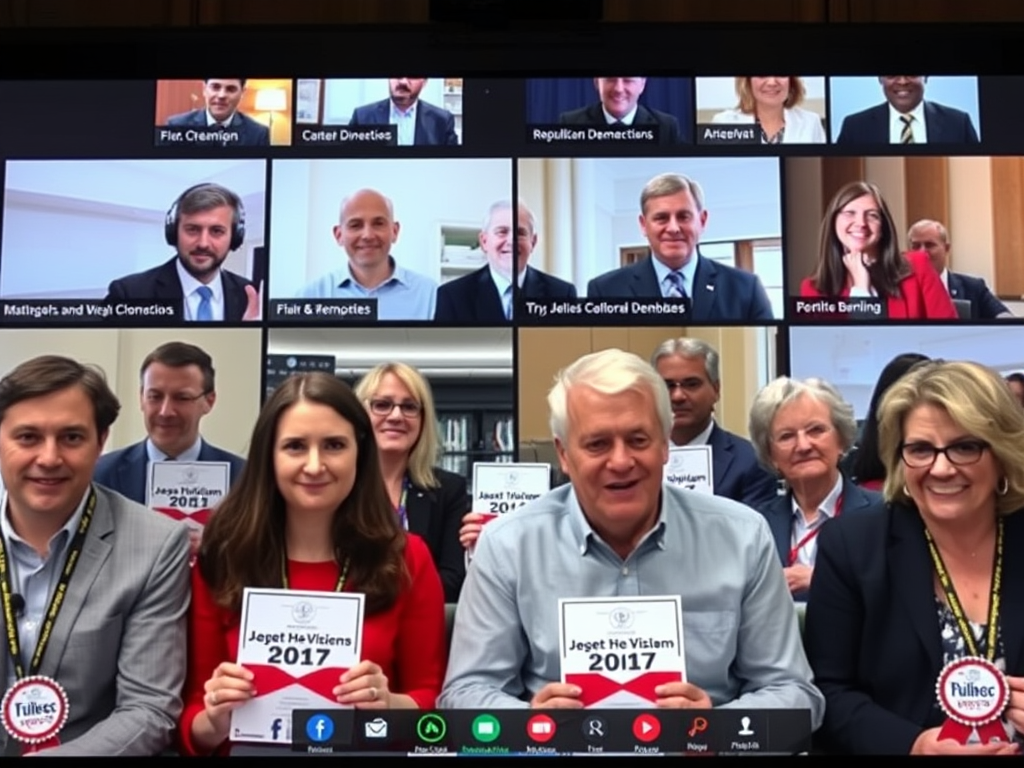
Image by Ralph Losey using Stable Diffusion.
Step 6: Incentivize Community Collaboration on Shared Issues
- Description:
- Objective: Support nonpartisan local projects addressing universal challenges like infrastructure, public health, or environmental sustainability.
- Impact: Builds trust and cooperation through shared problem-solving, reducing polarization at the community level.
- Implementation Strategy:
- Identify local, nonpartisan projects like disaster relief or environmental cleanups that encourage diverse participation.
- Provide financial incentives and public recognition for successful collaborations.
- Obstacles and Strategies:
- Obstacle: Risk of political framing of projects.
- Strategy: Focus exclusively on universal, nonpartisan issues like infrastructure or public safety.
- Obstacle: Limited interest in participation.
- Strategy: Offer small grants and public awards to increase motivation.
- Obstacle: Risk of political framing of projects.
- Action Items:
- Launch a “Community Builders Fund” to support local initiatives.
- Create a recognition program like “Hometown Heroes” to reward collaborative projects.
- Partner with businesses to provide matching grants.
- Evaluation and Assessment:
- Measure participation rates and project outcomes.
- Conduct surveys on perceptions of community trust and collaboration.
- Track the diversity of participants in funded projects.

Image by Ralph Losey using Stable Diffusion.
Step 7: Create Platforms for Bipartisan Citizen Engagement
- Description:
- Objective: Establish spaces—both virtual and physical—where citizens can collaborate on shared goals, such as disaster response or public safety, regardless of political affiliation. See e.g. PurpleAmerica’s Substack.
- Impact: Strengthened civic ties through visible, cooperative efforts.
- Implementation Strategy:
- Develop virtual forums and in-person town halls where citizens can collaborate on shared interests.
- Use AI tools to facilitate discussions and propose solutions.
- Obstacles and Strategies:
- Obstacle: Low initial participation.
- Strategy: Partner with trusted community leaders and influencers to promote platforms.
- Obstacle: Risk of unproductive debates.
- Strategy: Moderate discussions with trained facilitators and AI tools.
- Obstacle: Low initial participation.
- Action Items:
- Launch a bipartisan “Citizen Voices” platform for virtual collaboration.
- Host regional and national citizen summits to address shared concerns.
- Provide small grants for citizen-proposed initiatives.
- Evaluation and Assessment:
- Track participation and project completion rates.
- Assess user satisfaction and trust in the platforms.
- Measure engagement on specific issues tackled by citizens.

Image by Ralph Losey using Stable Diffusion.
Third Phase: Sustaining Unity Through Systemic Change
Step 8: Build Trust in Electoral Integrity
- Description:
- Objective: Enhance public trust in elections through reforms like transparent vote audits, improved election technology, and accessible voting systems.
- Impact: Restored confidence in democratic processes as a foundation for reconciliation.
- Implementation Strategy:
- Implement transparent vote audits and enhance election security technologies.
- Provide voter education on electoral processes to reduce misinformation.
- Obstacles and Strategies:
- Obstacle: Perception of partisanship in reforms.
- Strategy: Emphasize bipartisan oversight in all electoral integrity measures.
- Obstacle: Technical and funding constraints.
- Strategy: Partner with technology firms and civic organizations to develop cost-effective solutions.
- Obstacle: Perception of partisanship in reforms.
- Action Items:
- Launch a “Trust the Vote” initiative to promote transparency.
- Train election officials in secure, transparent practices.
- Fund research into advanced election security systems.
- Evaluation and Assessment:
- Monitor changes in public trust in elections through surveys.
- Track the implementation of election security measures.
- Measure the effectiveness of voter education campaigns.

Image by Ralph Losey using Stable Diffusion.
Step 9: Support Bipartisan Political Reforms
- Description:
- Objective: Advocate for initiatives like ranked-choice voting, independent redistricting, and transparency in governance to reduce partisanship and ensure fair representation.
- Impact: Strengthened democratic systems that work for all Americans.
- Implementation Strategy:
- Form bipartisan coalitions to advocate for reforms like ranked-choice voting and independent redistricting.
- Conduct public education campaigns on the benefits of these reforms.
- Obstacles and Strategies:
- Obstacle: Resistance from political leaders with vested interests.
- Strategy: Emphasize reforms as democratic improvements, not partisan maneuvers.
- Obstacle: Public misunderstanding of reforms.
- Strategy: Use clear, accessible communication to explain the benefits.
- Obstacle: Resistance from political leaders with vested interests.
- Action Items:
- Host informational sessions on political reform topics.
- Partner with civic groups to monitor reform implementation.
- Launch a “Fair Votes, Fair Voices” campaign to raise awareness.
- Evaluation and Assessment:
- Track public support for reforms through surveys.
- Measure implementation progress and voter turnout changes.
- Assess diversity and collaboration in reformed political institutions.

Image by Ralph Losey using Stable Diffusion.
Step 10: Address Socioeconomic Disparities
- Description:
- Objective: Promote job creation, affordable healthcare, and equitable access to education while addressing regional disparities.
- Impact: Reduced inequality and resentment, fostering shared purpose and unity.
- Implementation Strategy:
- Collaborate with local and national organizations to target regional economic disparities.
- Fund education, job training, and healthcare access programs in underserved areas.
- Obstacles and Strategies:
- Obstacle: Political disagreements on economic policy.
- Strategy: Focus on universal goals like job creation and affordable healthcare.
- Obstacle: Resource allocation challenges.
- Strategy: Use data-driven methods to prioritize high-need areas.
- Obstacle: Political disagreements on economic policy.
- Action Items:
- Expand funding for job training and retraining programs.
- Develop housing and healthcare initiatives tailored to local needs.
- Create economic development grants for underserved regions.
- Evaluation and Assessment:
- Track economic indicators like employment and poverty rates.
- Assess the effectiveness of education and training programs through participant outcomes.
- Monitor regional changes in economic opportunities.
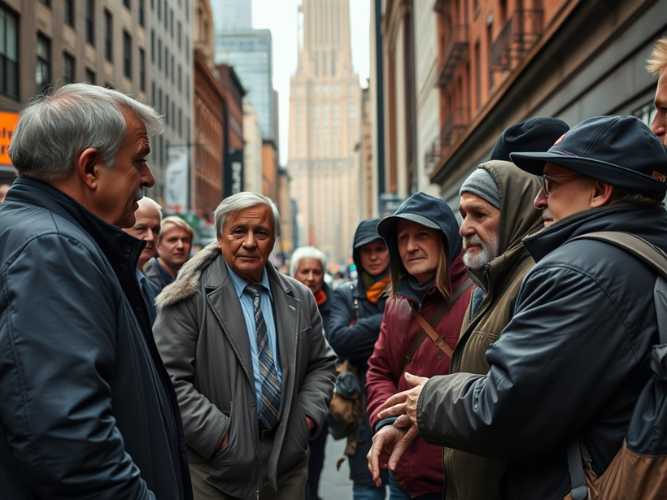
Image by Ralph Losey using Stable Diffusion.
Step 11: Embed Empathy and Perspective-Taking into Institutions
- Description:
- Objective: Introduce programs in schools, workplaces, and public services that encourage empathy and collaboration.
- Impact: A cultural shift toward mutual understanding and inclusion as the norm.
- Implementation Strategy:
- Partner with schools, workplaces, and public service organizations to integrate empathy and perspective-taking programs into their training and operations.
- Use storytelling, role-playing, and other experiential methods to foster understanding of diverse perspectives.
- Obstacles and Strategies:
- Obstacle: Perception of empathy programs as unnecessary or ideological.
- Strategy: Frame these programs as life skills that enhance communication, collaboration, and decision-making.
- Obstacle: Limited resources for implementation.
- Strategy: Develop scalable, low-cost online modules and leverage partnerships with local organizations.
- Obstacle: Perception of empathy programs as unnecessary or ideological.
- Action Items:
- Launch a “Walk in Their Shoes” initiative to provide empathy training in schools and workplaces.
- Develop online resources, such as interactive videos and AI-driven role-playing tools, for empathy-building exercises.
- Partner with media outlets to showcase real-life stories of empathy bridging divides.
- Evaluation and Assessment:
- Use pre- and post-program surveys to measure shifts in participants’ empathy levels and openness to diverse perspectives.
- Track engagement rates with online resources and participation in training programs.
- Analyze qualitative feedback from participants on the perceived impact of the initiatives.
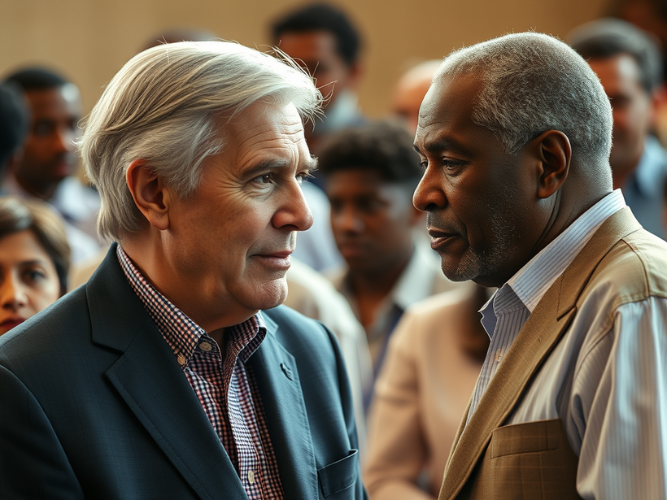
Image by Ralph Losey using Stable Diffusion.
Conclusion: Rebuilding America’s Unity Together
Healing America’s deep political divide is a monumental task, but with collective commitment and a clear plan, real progress is achievable. This eleven-step framework offers a pragmatic, inclusive path forward, addressing both the symptoms and root causes of polarization. By focusing on local empowerment, collaboration, and systemic reforms, the plan provides a roadmap for restoring trust, bridging divides, and fostering long-term unity.
While AI played an instrumental role in crafting this strategy, the true power to mend our ‘House Divided’ lies in our hands. As Abraham Lincoln reminded us in 1858, the strength of this nation depends on its people’s ability to unite in pursuit of a common purpose. Today, we have the tools, insights, and strategies to achieve this unity without the destructive conflicts of the past.

This path will not be easy. It requires courage, collaboration, and a willingness to engage with those who hold differing views. Yet, by taking small, tangible steps—together—we can create a ripple effect of change that transforms communities and rebuilds our national fabric.
Will you join this effort? Will you champion a step, organize a dialogue, or lead a local initiative? The success of this plan depends on ordinary Americans committing to extraordinary efforts. Together, we can prove that the ideals of unity and democracy are more than just words; they are our collective reality.




Pick an Action Plan | Think Global | 11-Steps | Start Acting Local
Images by Ralph Losey using Stable Diffusion.
Now listen to the EDRM Echoes of AI’s podcast of the article, Echoes of AI on AI’s 11-Step Plan for Unity. Hear two Gemini model AIs talk about this article. They wrote the podcast, not Ralph.
Pick one, or many, of the thirty-three projects outlined in the Plan to Unite America and let us know. See here for more details on each project. Be part of the solution.
If you would like to learn more and become involved in any way, start off by contacting Ralph:
Please use ralph.losey@gmail.com
Ralph Losey Creative Commons Copyright 2024. Distribution of this document is encouraged with attribution, but do not modify without Losey’s permission.
Assisted by GAI and LLM Technologies per EDRM GAI and LLM Policy.


